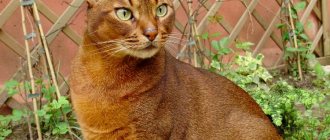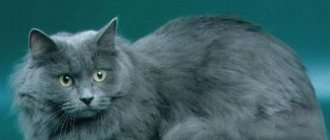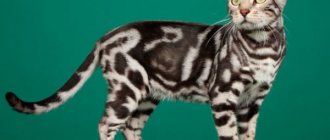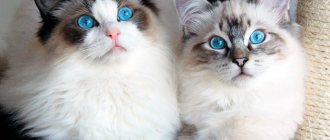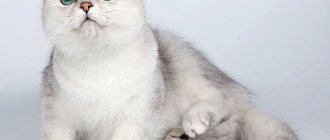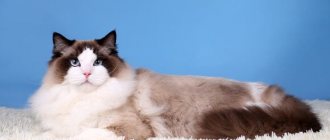Description of the Singaporean cat breed
The head of the Singapura cat is round, the nose is small and blunt. Cats have a well-developed chin.
Singapura cat ears: large, long, with a deep and pointed pinna.
The eyes of the Singapura cat are large, wide open, slightly slanted. The color can range from gold to copper shades.
Body of the Singapura cat: small but muscular
Singapura cat limbs: medium length
Singapura cat's tail: medium length and thick
The Singapura cat's coat: Short, silky, evenly covering the body.
Types of colors of the Singapore cat. True representatives of the Singapura cat breed have only one color, “sepia agouti” - a golden-cream tone, which has dark brown ticking on the back, tail and head.
Parameters, weight, size of the Singapore cat. Singapura cats are among the smallest cats. The weight of adult cats does not exceed 3 kg, cats weigh on average 2 kg.
Breed characteristics
The Singaporean cat differs from its counterparts not only in its small size. The cat is graceful and miniature, has a small round head, a blunt nose that forms one line with the chin. The cat's ears are located at the edges, parallel to each other or slightly apart. The ears are wide and large relative to the head. If the ears of a Singapura are small, the cat will be disqualified by experts.
Singapuras have large, shiny, oval-shaped eyes. The eyes are wide-set and can be green, yellow or yellow-green. A cat with such eyes looks constantly amazed and surprised, which is why breeders especially love her.
See also: Tailless cat breeds: myths and reality
The Singapura cat has a strong and muscular body, strong legs of proportional length. The paws are oval and rather small in size.
The Singapura's tail has its own standard and should be round at the base, straight and tapering towards the end, the tip of the tail should be rounded. The length of the tail should be equal to the distance from the base to the shoulders along the back.
Cats of this breed are short-haired, the hairs of the coat are relatively thin, but dense in texture, light at the roots and dark towards the edges. The peculiarity of the Singapura wool is that during shedding the cat loses very little hair; many owners do not even notice this period.
Color standards allowed: sable, ivory. It is known that breeders managed to achieve peach and even pinkish coat colors in Singaporeans; ticking makes their coat shiny with a noticeable iridescence. According to international standards, the upper part of the body, the upper part of the tail and the tip of the tail should be dark in color. Dark stripes on the inner parts of the forelimbs and the knees of the hind legs are acceptable.
Story
Despite its Asian origin, the Singapura cat breed was developed by Americans. As the story goes, an American geophysicist, having arrived in Singapore on business, saw there cats of an unusual color even for Asia, and the size of the cat was very small. He sent four of these animals to his friend in the USA, who was breeding Siamese and Abyssinian cats and was interested in precisely these brownish colors. These four (Singapore cat and three cats) are the founders of the breed.
But since the animals were, in fact, homeless, at first the breed could not be registered, and its development was associated with some difficulties. Ten years after the first Singaporeans, other breeders specially went to Asia to bring native animals to American nurseries, but with the appropriate documents, and cross them with established local, American Singaporeans. Soon their efforts were rewarded with success and the breed was officially recognized.
- Cat meowing
- Alexandrian parrot
- Why does a cat need a mustache?
- Rescue dogs
- Hypoallergenic cats
- Why does a cat need a tail?
Diseases
Like all breeds that were bred by nature itself, Singaporean cats are distinguished by truly indestructible health. If you provide good care and proper nutrition, the most that a Singaporean can catch is a cold. Once ill, the animal becomes lethargic, constantly sneezes, and rubs its muzzle with its paw. The temperature may rise slightly, clear mucous discharge from the nose appears, and the mouth is constantly slightly open. Sometimes the mucous membrane of the eyes becomes inflamed, and the animal seems to cry.
At the first sign of a cold, your cat should be taken to a veterinarian immediately. This disease can be cured fairly quickly, but causes a lot of inconvenience to the cat. Don't forget that your pet can't even blow his nose! It’s hard for him to eat, drink, and breathe.
Singaporeans do not tolerate cold and damp well. Perhaps this is why they have not become widespread in our harsh climate.
Character
Singapuras are very affectionate and calm cats. Incredibly gentle and loving, smart and curious, quite agile and playful, graceful and love to stand on their hind legs. They become unusually attached to people and give their care. If someone in the family is sick, she will lie with you for a long time and purr. They have a gentle, quiet voice and prefer to curl up and bask on their laps. Thanks to its ideal character, Singapore is perfect for families with children and animals. The only difficulty may be shyness.
Miniature Singaporeans have an amazing character and developed intelligence. By the way, they easily get used to their nickname and respond to it. They adore people and get along well with them. Your little one will follow you around no matter what you do. But she will also be able to show tact and will not impose her company when you need to be alone with yourself.
Singapuras are very playful and can play around endlessly. Their character is simultaneously full of irrepressible energy and great modesty. This cat has great respect for humans. Her gentle disposition, gentle and quiet voice, combined with her unusual appearance make this fluffy beauty just a godsend. And what an affectionate mother she is! Even to kittens of a different breed that find themselves under the same roof, she will show attention and take care of them as if they were her own.
Health
Typically, Singapura cats are predisposed to a disease called uterine inertia. With this disease, the cat cannot give birth on its own, but veterinarians solve this problem by cesarean section. The procedure is usually performed under general anesthesia, and cats recover quickly after surgery. The Singapura breed is not prone to any genetic diseases. Don't forget about vaccinations and deworming. They are sensitive to drafts and can catch cold easily.
Care
Singapura cats have a high sense of cleanliness, so you should always thoroughly clean the tray and wash food bowls - she will refuse to eat from dirty dishes. Otherwise, Singapura cats are very independent and do not require special care. It is enough just to comb them once a week and clean their ears and eyes as needed with a damp cloth soaked in warm boiled water.
Cats are in excellent health, but they do not tolerate cold and drafts well and can catch colds. Therefore, the bed should be placed in a warm place where the wind does not blow. In addition, do not forget about vaccinations and carry out vaccinations in a timely manner. Then, nothing will threaten the cat’s health.
Singapura cats have an excellent metabolism that can only be envied: they are not at risk of obesity, no matter how much they eat. But you still need to ensure that your diet is balanced, varied and healthy. These cats do not need special diets.
Care and maintenance
Singapura grooming is minimal: brush with a soft brush once a week, trim nails, look in ears, brush teeth (if taught to do so since childhood). An active lifestyle will require owners to provide them with a large living space and a sufficient number of toys. Singapuras have an excellent appetite, so if you notice clearly extra grams, switch your cat to light food. Some owners prefer natural food, claiming that the Singapura eats boiled turkey, chicken and raw meat perfectly. You can also choose super premium food and feed it strictly according to the norm.
Feeding
This cat may not take care of her figure - Singaporeans are not at risk of obesity. Diets are for cowards, and the Singapura cat is only afraid of drafts.
However, proper nutrition is the key to good health.
Natural nutrition should be balanced. You should not feed your Singapura cat pork, sausages, river fish, sweets or milk. Grains, lean meats, non-red vegetables - a great menu for Singapore! Ready-made feeds must contain at least 30% meat, and their digestibility must be at least 80%.
Nutrition
Singapuras are one of those breeds that can eat as much as they want without getting fat. But this does not mean at all that they can be fed with anything, especially with food from our table. Pork, lard, river fish, smoked sausages, whole milk, cream, spices - all this should be strictly prohibited.
If you are going to feed your cat natural products, give preference to lean chicken or turkey meat, boiled liver, and offal. Occasionally, you can treat your pet to a piece of sea fish, but you should not include it in the daily diet: in large quantities, fish can provoke the development of urolithiasis, from which cats suffer greatly and often die.
Meat should make up about a third of your daily diet. It is preferable to give it minced and mixed with porridge cooked from one or several types of cereals: rolled oatmeal, buckwheat, rice. An excellent addition would be boiled vegetables: potatoes, cabbage, beets, carrots, zucchini, all types of legumes. They can be cooked separately or together with meat, so the cat will eat them even more willingly. Many animals eat fresh cucumbers and green peas with appetite.
Kefir and low-fat or low-fat cottage cheese are very useful for cats. They are indispensable as a source of calcium, are well absorbed and help digest heavier foods.
It will be more convenient for busy owners to feed their pets with ready-made super premium and premium food. They are perfectly balanced and completely ready to eat.
Fresh water should be available to your cat at any time of the day.
Wash your pet's bowl thoroughly with hot water every day. You should not use dishwashing detergents: the smell is almost imperceptible to us and can take away your cat’s appetite for a long time. In addition, insufficiently thoroughly washed off remnants of this liquid often cause nausea, vomiting and stomach upset.
Leisure
One of the Singapura cat's favorite pastimes is games . Surprisingly, they can, just like dogs, catch toys, run after them and bring them to their owner! Playing with a Singapura cat is incredible fun. A charge of energy and positive emotions is guaranteed!
Don't have time to clean out your closet? The Singapura cat will do this for you with great pleasure and genuine interest! She will spend a long time getting acquainted with all the things lying in the closet, and then, tired, she will fall asleep, curled up on her favorite shelf. Of course, to get tired, the Singapura needs to roll around a fair amount, since it is an unusually energetic and, at the same time, intelligent animal. Be prepared that studying one closet may not end the matter. Any item can become a toy for a Singaporean. But, for all their curiosity and liveliness, these are not mischievous animals. And they won't cause any trouble. And how can you be angry with these intelligent, deep, devoted eyes?
Features of behavior
Singapura cats combine seemingly opposite character traits: energy and calmness, independence and affection for the owner. In communication, representatives of this breed do not cause trouble or burden. They can be found in families with children - cats will play with the kids and lie quietly next to them when the child is sleeping.
Singapura cats are characterized by increased curiosity, so you have to take care that they don’t get into trouble by getting into places where they don’t belong.
Singapuras are very clean, so training them to use a litter box will not be difficult.
Buying a kitten
Unfortunately, there are very few nurseries that deal only with Singaporeans, but you only need to go there or to a large multi-system exhibition. Buy kittens only at 3-4 months of age. The appearance of these cats is a good clue in identifying the breed. Even kittens have eyes that are very far apart (wide bridge of the nose). Take a closer look at the fur, it should all be striped (two dark, two light and a dark tip on each hair). The paw pads are always brown. Although the breed is considered the smallest in the world (in fact, this was just a publicity stunt), a kitten in your arms should not look too small for 3-4 months, much less skinny with protruding ribs and spine.
Make sure that the vaccinations were done at the veterinary clinic and that the veterinary passport is dated, ask about the baby’s habits, and play with him. A reputable breeder will not sell a Singaporean without a contract, which will stipulate, for example, mandatory castration/sterilization or participation in exhibitions in the advertising class. Singapura kittens are available for purchase in nurseries only at the age of 3-4 months, when they are ready to leave their mother, are toilet trained and accustomed to a scratching post, and have received all the necessary vaccinations. In this case, you get not only an unusual kitten that can be sent to exhibitions and competitions, but also a faithful, devoted friend and family member.
Appearance and color
Singapore cats are the smallest breed in the world. Due to its miniature size, the breed is listed in the Guinness Book of Records. The weight of an adult cat does not exceed 2.5 kg, a cat - no more than 3 kg. Despite their size, cats of this breed are quite strong and muscular. The tail is of medium length - reaches to the shoulders.
The Singapura's head is small and round in shape. The ears are quite large and wide, their outer edges should be parallel or slightly diverge towards the top. The cat's face looks surprised. It's all about the almond-shaped eyes - they are simply huge, which noticeably contrasts with the overall size of the body. Eye color can be yellow-green.
The coat is very short, soft and silky to the touch. Each hair on the body of a Singapura cat has at least two stripes. In this case, the tip is always dark and the root is light. The Cat Federation recognizes only 2 colors: Sable with a lighter chin, chest and belly. “Ivory” - the main part of the body is covered with golden-cream fur, and the ears, head, back and tail have a brownish tint.
Popularity
There are few nurseries for Singapura cats, not only here, but all over the world. Today, the main population of the breed is in the USA; there are also nurseries in Austria, France, Germany, Belgium, Holland, Canada, and Australia. Several - in Denmark, Switzerland, the Netherlands. In Singapore itself, four years ago there was only one nursery, and one in Japan. And among European countries, perhaps most of them are in Great Britain. Singapore's show rating is low: they have too many competitors in the shorthair group.
Price
Singapore cats are quite rare and the number of catteries in Russia and other countries is very small. Not many breeders can boast of small Singapore cats.
Speaking about the cost of a Singapura cat, it is worth noting that this is a rather rare breed and is not common outside the United States. In other countries, including Russia, the number of Singapore cat nurseries is negligible, and accordingly the price of an individual is high: from 20 thousand rubles (a kitten without a pedigree) to 120 thousand (a purebred kitten). Cats are more expensive than female cats.
Owner reviews
Reviews about the Singapura cat are not very common on the Internet, which is not at all surprising, because this is a very rare breed.
One of the breeders writes that her cat Irma, a little coward, does not like active games at all, but outwardly she always remains a kitten. She does not misbehave, behaves proudly and obediently, looks quite exotic and unusual. She prefers a calm, half-asleep existence. She is affectionate with her owner, but very timid with strangers. She doesn’t like to walk outside and is “particularly partial” to indoor plants.
Facts about the Singapura cat
- Singapore cats are so named because their main habitat was previously the Republic of Singapore, from where an American couple took three cats in 1971 and later tried to register them as a breed.
- After 20 years, after numerous inspections, Singapuras gained recognition and became the smallest breed.
- It is interesting that in their homeland these cats in most cases lived in the drainage canals of the city. The government then adopted a program to clean up the drainage systems. As a result of the implementation of the program, some of the cats died, and the second part was forced to leave their historical habitat. And in 1991, cats of this breed were proclaimed a national symbol and several statues were erected in their honor.
- Although the breed is considered natural, breeders still made some changes. For example, they added a pinkish-beige tint to the color. Now cats with a different shade are not considered a pure breed, even by their ancestors still living in Singapore.
- The character traits of representatives of this breed include sociability, playfulness and lack of conflict. Even adult cats continue to play around like kittens, and cats can live peacefully in the same cage.
- Also, Singapura cats do not like the cold. Perhaps that is why they are not very common in Russia.
- Singapura cats are distinguished by their affection for their owner; she meets him and sees him off when he either leaves the house or returns. Most of all, they love to perch on the shoulders of the owner and watch those around him from his height. Singapura cats also love to sleep on their laps, curled up in a ball. If the owner is unwell, the cat can sit on his chest for several hours.
- Thanks to their highly developed intelligence, the Singapura cat is a kind and affectionate creature, but they do not lose their playfulness throughout their lives.
- This breed does not require special care; the most important thing for it is that the owner feeds it on time and does not deprive it of affection and attention. This is very true, like most cats, an animal that constantly needs care and attention.
Video
Health, vaccinations and nutrition
Singapuras are cats in the selection of which people have interfered slightly. They are bred and genetically determined by natural conditions. Therefore, their health is relatively strong and stable. When keeping a cat, you should carefully monitor the condition of the nose, ears, teeth, and pay attention to the mood and appetite.
Cats of this breed are very thermophilic, they cannot stand cold and drafts, so in countries such as Russia and Ukraine it is quite problematic to keep Singaporeans. The tendency to colds is due to the fact that the cat is genetically accustomed to a warm, humid climate; its coat is not designed for frost and cold, so heat transfer increases in cool weather, and the cat begins to freeze.
However, Singapura cats are prone to certain diseases. Some of them are due to the fact that cats gain excess weight after sterilization or with little activity. In this case, they are at risk of diabetes and obesity of internal organs. There are pathologies of the urinary tract and cardiovascular system, and sometimes problems arise in the musculoskeletal system.
The fact that Singapura cats are relatively few in number suggests that they are, one way or another, related to each other. This contributes to the development of infertility, internal pathologies of the reproductive system and related diseases.
If unhealthy symptoms appear (discharge from the ears, nose, eyes, lethargy), you should contact a veterinarian.
Feeding a Singapura cat should be organized correctly, and the diet should consist of balanced food with sufficient amounts of proteins, fats and carbohydrates. It is recommended to use ready-made food, luxury and premium canned food.
If you decide to feed your cat regular foods, exclude fatty meat and poultry (lamb, pork, duck), river fish and any food from the owners’ table from its diet. By giving your cat the “wrong” food, you expose it to disease and shorten its lifespan.
The vaccinations that Singaporeans require are standard. At 12 weeks you should get an anti-infectious vaccination and repeat it a month later. A rabies vaccination is also required.
See also: Chinchilla cat
